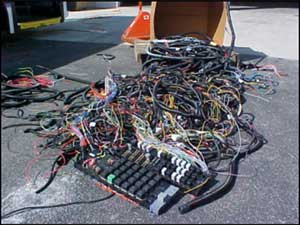
A system that allows electrical components to communicate
in a new and more efficient manner.
Rather than using a multitude of copper wires between each
switch, relay, and component, individual solid-state modules,
or “nodes” use microprocessors to communicate
between each other to activate the selected circuit

|
Using conventional wiring, each and every switch in the system
requires an individual copper wire from the switch,
to a relay, to the device being activated
The quantity of wire and connections
can be enormous, especially if several additional
switches activate the same circuit |
|
In a multiplexed system , the signal is carried along a simple
twisted pair of wires called the network data
bus
The Universal System Manager then interprets
the correct logic and continues the signal to
the affected node, which activates the device
|
|
Physical Layer
- Uses Controller Area Network (CAN) bus
- Simple 8 bit signals
- Signal transfer rate of 250,000 bits per second up to
500,000 bits per second
- SAE J-1939 protocol

ADVANTAGES
- More reliable electrical system
- Advanced load management
- Unmatched real-time, onboard diagnostic capabilities
- Fewer light duty mechanical parts
- Easily re-configurable
- Vehicle weight reduction
- Less downtime
- Quick, accurate information returned to the operator
|

Wiring that we don’t have to worry about troubleshooting
anymore!!! |
|